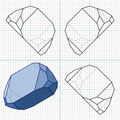Heptadecahedron
- Machine translation, like DeepL or Google Translate, is a useful starting point for translations, but translators must revise errors as necessary and confirm that the translation is accurate, rather than simply copy-pasting machine-translated text into the English Wikipedia.
- Do not translate text that appears unreliable or low-quality. If possible, verify the text with references provided in the foreign-language article.
- You must provide copyright attribution in the edit summary accompanying your translation by providing an interlanguage link to the source of your translation. A model attribution edit summary is
Content in this edit is translated from the existing Chinese Wikipedia article at [[:zh:十七面體]]; see its history for attribution. - You may also add the template
{{Translated|zh|十七面體}}to the talk page. - For more guidance, see Wikipedia:Translation.
A heptadecahedron (or heptakaidecahedron) is a polyhedron with 17 faces. No heptadecahedron is regular; hence, the name is ambiguous. There are numerous topologically distinct forms of a heptadecahedron, for example the hexadecagonal pyramid and pentadecagonal prism.
Convex
There are 6,415,851,530,241 topologically distinct convex heptadecahedra, excluding mirror images, having at least 11 vertices.[1] (Two polyhedra are "topologically distinct" if they have intrinsically different arrangements of faces and vertices, such that it is impossible to distort one into the other simply by changing the lengths of edges or the angles between edges or faces.)
The infinite Laves graph has convex heptadecahedral Voronoi cells. Because of the symmetries of the graph, these heptadecahedra are plesiohedra form an isohedral tessellation of three-dimensional space.[2]
-
 The heptadecahedron that tiles space in the Voronoi diagram of the Laves graph.
The heptadecahedron that tiles space in the Voronoi diagram of the Laves graph. -
 The pentagonal rotunda (J6)
The pentagonal rotunda (J6) -
 The triaugmented hexagonal prism (J57)
The triaugmented hexagonal prism (J57) -
 The augmented sphenocorona (J87)
The augmented sphenocorona (J87)
References
- What Are Polyhedra?, with Greek Numerical Prefixes
External links
- v
- t
- e
- Monohedron
- Dihedron
- Trihedron
- Tetrahedron
- Pentahedron
- Hexahedron
- Heptahedron
- Octahedron
- Enneahedron
- Decahedron
- Icositetrahedron (24)
- Triacontahedron (30)
- Icosidodecahedron (32)
- Hexoctahedron (48)
- Hexecontahedron (60)
- Enneacontahedron (90)
- Hectotriadiohedron (132)
- Apeirohedron (∞)
- face
- edge
- vertex
- uniform polyhedron (two infinite groups and 75)
- regular polyhedron (9)
- quasiregular polyhedron (16)
- semiregular polyhedron (two infinite groups and 50)
- Platonic solid (5)
- Archimedean solid (13)
- Catalan solid (13)
- Johnson solid (92)
- Kepler–Poinsot polyhedron (4)
- Star polyhedron (infinite)
- Uniform star polyhedron (57)
- prism
- antiprism
- frustum
- cupola
- wedge
- pyramid
- parallelepiped
 | This polyhedron-related article is a stub. You can help Wikipedia by expanding it. |
- v
- t
- e














